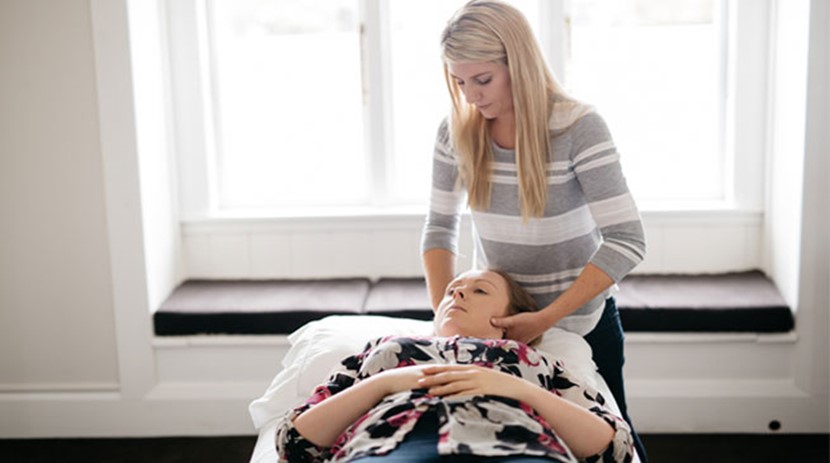Easy does it: natural ways to manage pain after childbirth

After your baby is born a few aches and pains can arise while adapting to parenthood. It can take your body a while to adapt to some of the new tasks that come with having a baby. During pregnancy, your hormones work to loosen muscles, ligaments and joints to allow for the growing baby and to prepare your body for birth. It can take a few months for your body to return back to normal, making it more prone to aches and pains. Some common activities that can cause pain for mother’s include; breastfeeding, changing and dressing babies, bath time and carrying the car capsule. Osteopaths commonly treat mothers for muscle strains, neck and shoulder pain, pelvic pain, postural issues and back pain.
BREASTFEEDING
Whilst breastfeeding can be a joyful and humbling experience for one mother, it can be very painful for another. There are many causes for pain during breastfeeding, relating to latch, nipples, babies position and mum’s posture. Always consult to your midwife or doctor if you are experiencing any pain. Advice I give my clients includes; having your shoulders relaxed, lower back well supported, a comfortable chair, a foot stool to elevate your feet slightly and a pillow under the baby and/or your elbow to support the baby. You can also ask your midwife your various positions for feeding which best suit you and your baby.
CHANGING AND DRESSING YOUR BABY
Newborns are very floppy to begin with before they grow into squirming toddlers, but even being a lighter weight, the task of changing or dressing a baby can still create aches and pains for mum. If changing or dressing your baby causes you pain, try changing them in a different location. Sometimes the easiest place might be the floor or on another surface which is a more suitable height for example the dining room table or the bed. As newborns frequently need their nappies changed make sure where you change them is a suitable height for you. You should not feel any strain in your back, shoulders or neck. Try having everything you need within arms reach to avoid straining your neck and shoulders each time you reach for that nappy you forgot.
BATH TIME
Some babies love the bath, whilst others at first are not so keen. Your midwife can show you various ways to hold your baby enabling you to find what is most comfortable for you. If you are using a small bathtub, place the bath on a surface that is most suitable for you, making sure you are not straining your back and your shoulders are relaxed.
CAPSULES
Having your baby in a capsule can definitely come in handy, especially when they fall asleep in the car, but as they grow they become very heavy. Capsule car seats can be very awkward to carry. By carrying them using one hand, normally means you lean in the opposite direction to counter balance the weight. This can strain your back muscles and other joints. I advise my clients to carry their capsule in front of their tummy, this means the centre of gravity is centralised and not straining to one side. Also don’t put off transferring your baby into the next stage car seat which is fixed into the car. Once the capsule becomes too heavy it will make you more prone to injury when lifting and carrying it. Try only carrying the capsule when necessary, if your baby is awake when you get home, you could just carry them inside, instead of bringing the capsule in with you.
WAYS TO DEAL WITH THE PAIN
Job delegation
My strongest piece of advice is always job delegation. This is not necessarily because you are in pain, but it gives you a rest and a chance for partners or loved ones to have some one-on-one time with your baby. This might include nappy changing or bath time for example. Parents need as much rest as possible to cope with the disrupted sleep and adapting to parent life. By delegating jobs, that five minutes of rest might make the day more achievable.
Stretches
Simply rolling your shoulders forwards and backwards, in a circular motion can help relieve tight neck and shoulder muscles. Also gently tipping your head to the side can help stretch the neck muscles. Stretches are best advised by your health professional.
Exercise
Once advised by your health professional, short, gentle walks are a nice way to start building up muscle tone, clear your mind and get some fresh air. Start off with a short walk and slowly build up the duration and intensity, at your own pace. Wear supportive shoes to ensure no further strain is placed on the body.
Osteopathic treatment
Osteopathy is a hands-on, natural form of pain relief, using gentle techniques including soft tissue massage, joint mobilisation and tailored advice to the client. Postnatal treatment can be beneficial with helping mum recover. Checking for correct alignment on the pelvis and lower limbs, as uneven pressure can be put on these areas during birth. Also aiding muscle balance and alleviating any developing aches and pains. Each treatment is tailored to the individuals needs and specific advice is given.
|
Sarah Boughtwood is a Takapuna-based osteopath, specialising in pregnancy and back pain. |

